ARCHIVED - RPP 2006-2007
Immigration and Refugee Board of Canada
 This page has been archived.
This page has been archived.
Archived Content
Information identified as archived on the Web is for reference, research or recordkeeping purposes. It has not been altered or updated after the date of archiving. Web pages that are archived on the Web are not subject to the Government of Canada Web Standards. As per the Communications Policy of the Government of Canada, you can request alternate formats on the "Contact Us" page.
Monte Solberg
Minister of Citizenship and Immigration
Message from the Executive Director
Management Representation Statement
Summary Information
Section 2: Detailed Analysis of Program Activities
Admissibility Hearings and Detention Reviews Program Activity
Immigration Appeal Program Activity
Corporate Management and Services Program Activity
Section 3: Supplementary Information
Section 4: Other Items of Interest
Section 1: Overview
Message from the Chairperson

I am pleased to present the 2006-2007 Report on Plans and Priorities for the Immigration and Refugee Board of Canada (IRB).
Why Our Decisions Matter
The IRB is an administrative tribunal whose work reflects Canada's humanitarian values and respect for our international obligations.
As an independent organization, the IRB is entrusted with unique responsibilities within Canada's immigration and refugee protection system. IRB decision-makers hear cases and render decisions on some of the most complex and compelling issues in administrative law. In the course of their work, decision-makers will hear cases on family reunification, detention reviews, admissibility to Canada, appeals from removal orders, and claims for refugee determination. The importance of these issues, and the consequence of the decisions, confers an enormous responsibility on decision-makers, and all who work at the IRB. It is with this sense of responsibility to those who appear before us, and to all those who count on us to uphold the integrity and fairness of the decision-making process, that we at the IRB undertake the plans and priorities detailed in this report.
A Changing Environment
One of the key factors of the IRB's planning and operating environment is that it has no control over the number or the kind of cases it hears. Factors affecting the IRB's workload include immigration trends and global migration patterns. While the principal issues for adjudication remain constant, the volume and the kind of cases brought forward are in constant flux.

Achieving Excellence at the IRB
The IRB has been recognized in the international community for having achieved a level of excellence in refugee determination and immigration adjudication. For example, our refugee determination system has been praised by the United Nations High Commissioner for Refugees (UNHCR) as a model of best practices.
To ensure the consistent delivery of high-quality administrative justice amidst a changing environment, the IRB has been engaged in a process of transformation to become more responsive and dynamic, as befitting its role as a tribunal. We continue to seek new and innovative ways of fulfilling our mandate and honouring our commitment to those who appear before us. The strategic priorities and program activities from across the organization converge around a single, essential point: the delivery of high-quality administrative justice in the most efficient way possible, without compromising fairness.
One example of this has been the changes brought forward to the process of refugee determination. In response to a spike in the number of refugee claims in 2002, we began a process of transformation which included streamlining the hearing process, the introduction of Chairperson's guidelines, improved case management, and better use of available technology.
Our success in lowering the backlog of refugee claimants is not about numbers. People awaiting a decision for long periods of time have to put their lives on hold. By rendering quality decisions in a timely fashion, the IRB is able to take people out of a state of uncertainty and allow them to get on with their lives.
Key Priorities for 2006-2007
To build on our success and to continue the process of organizational transformation, we are focused on the following four strategic priorities for 2006-2007:
- Integrate common procedural, administrative and adjudicative activities in all IRB Divisions to further promote quality, consistency and efficiency measures
- Continue to build an organizational culture that supports its people, and is flexible and innovative
- Improve case management processes through the successful implementation of the Integrated Case Management System (ICMS)
- Implement a horizontal and fully integrated management plan that reflects the IRB's reality
In line with these strategic priorities, the IRB will focus on a number of initiatives in the year ahead. These include:
- Launching the implementation of the Immigration Appeal Division (IAD) Innovation Initiative that will transform how the IAD processes and adjudicates immigration appeals
- Continuing the IRB's vision of making the system of justice at the IRB responsive and accessible. For example, the IRB will introduce a new guideline on vulnerable persons which will address the special circumstances of women, children, victims of torture, persons with mental illness and other vulnerable persons
- Exploring further reforms in the Refugee Protection Division and the Immigration Division to advance the goal of efficient and fair decision-making
- Continuing to reach out to stakeholders in Canada and our counterparts elsewhere in the world in order to promote high standards of fairness in refugee and immigration adjudication, both in Canada and internationally
- Enhancing the significant measures already taken to ensure a merit-based appointment and reappointment process for IRB decision-makers
Looking Ahead
In the year ahead, we will continue to look for opportunities to transform the way we do business. In this regard, I would like to acknowledge the commitment and dedication of our highly qualified, experienced and proficient decision-makers and employees who are key to ensuring that we meet our objectives and commitments.
I invite you to read this report and to visit our website at www.irb-cisr.gc.ca for more information about the IRB, and its plans and priorities for the coming year.
Jean-Guy Fleury
Chairperson
Message from the Executive Director
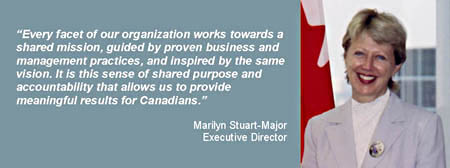
The IRB Report on Plans and Priorities for 2006-2007 outlines our mandate, identifies our strategic priorities, activities and results in alignment with the Government of Canada's modern management agenda. The IRB continues to improve its business practices by introducing innovative and rigorous management processes and initiatives to achieve benefits for Canadians and to support the high quality of the decisions rendered by the IRB's decision-makers.
A Dedicated and Committed Team
A key strength of the IRB is the ability of its people to respond to the challenges of a constantly changing environment. As an organization with the mandate to render decisions on immigration and refugee protection matters, this ability provides assurances to those who appear before us that the justice they expect will be delivered in a timely, fair, and efficient manner, in all types of cases.
The past year saw a decline in the number of refugee claims in the Refugee Protection Division (RPD), and an increase in the number of cases in the Immigration Appeal Division (IAD). Shifting immigration trends and global migration patterns are factors beyond the control of the IRB, but have a major impact on the workload of the Board. It is in this respect that we have embarked upon a process of transformation: to be more flexible as an organization and more particular in aligning resources to workload. Throughout this process, our people have continued to demonstrate their commitment and dedication to the IRB.

There is a direct link between the work of IRB staff and the quality, fairness and efficiency of the decisions the IRB renders. Every facet of our organization works towards a shared mission, is guided by proven business and management practices, and is inspired by the same vision. It is this sense of shared purpose and accountability that allows us to respond effectively to the fluctuations in the kind of cases brought before the tribunal.
Building on Our Strength
In 2006-2007, the IRB will continue to adapt to external factors by focusing on innovation and change and moving towards the greater integration of our operations. In doing so we will ensure that our people have access to a full range of opportunities. For example, beginning in April 2006, the IRB will embark on a joint project with the United Nations High Commissioner for Refugees (UNHCR) which will allow IRB employees to provide training and guidance to UNHCR staff overseas on issues related to refugee determination. This agreement between the IRB and the UNHCR is testimony to the professionalism and expertise of IRB employees and the high regard in which they, and the IRB as a whole, are held by the international community.
Delivering Results for Canadians
Our agenda for continuous improvement will ensure that the IRB has the flexibility it needs to deliver on its business commitments. In the coming year we will achieve excellence throughout the organization by building on our success, delivering solid results to Canadians, reporting key information to Parliament, and applying sound management practices. Success will result in the IRB being recognized as a leader in public sector management and a model for the world.
Marilyn Stuart-Major
Executive Director
Management Representation Statement
I submit for tabling in Parliament, the 2006-2007 Report on Plans and Priorities (RPP) for the Immigration and Refugee Board of Canada.
This document has been prepared based on the reporting principles contained in the Guide for the Preparation of Part III of the 2006-2007 Estimates: Reports on Plans and Priorities and Departmental Performance Reports:
- It adheres to the specific reporting requirements outlined in the TBS guidance
- It is based on the department's approved Program Activity Architecture structure as reflected in its Management Resources and Results Structure (MRRS)
- It presents consistent, comprehensive, balanced and accurate information
- It provides a basis of accountability for the results achieved with the resources and authorities entrusted to it
- It reports finances based on approved planned spending numbers from the Treasury Board Secretariat in the RPP
Marilyn Stuart-Major
Executive Director
Summary Information
Raison d'être
Who we are
The Immigration and Refugee Board of Canada (IRB) is an independent administrative tribunal that reports to the Parliament of Canada through the Minister of Citizenship and Immigration Canada (CIC). As Canada's largest federal tribunal, the IRB consists of three divisions, each of which has its own mandate under the Immigration and Refugee Protection Act (IRPA):
- Refugee Protection Division (RPD)
- Immigration Division (ID)
- Immigration Appeal Division (IAD)
The IRB employs approximately 1050 people in its headquarters office and regional offices. Through each division, the IRB delivers a simpler and faster form of justice than that provided by the courts, but with no less attentiveness to the rigour of the law. The IRB is a human rights tribunal, and the men and women who work at the Board respect the human dignity of all those who come before it.
The IRB is fully committed to applying fairness to all aspects of its work, which in turn means being just, lawful, honest, open, and without bias. This includes recognizing that some individuals who appear before our Board have experienced very difficult circumstances, and respecting the diversity of cultures of individuals who appear before the IRB. Most importantly, it means recognizing that the determination of each case directly and profoundly affects the lives of people.
We are the organization we are meant to be
| MISSION | |
| The Immigration and Refugee Board of Canada is an independent tribunal established by the Parliament of Canada. Our mission, on behalf of Canadians, is to make well-reasoned decisions on immigration and refugee matters, efficiently, fairly, and in accordance with the law. | |
| VISION | VALUES |
| We will excel in everything we do and will deal simply, quickly and fairly with everyone. Through innovation and flexibility, we will be a leading-edge administrative tribunal and a creative partner in building the future of the Canadian immigration system. |
|
As an organization responsible for applying administrative justice, the IRB adheres to the principles of natural justice, and its decisions are rendered in accordance with the law, including the Canadian Charter of Rights and Freedoms. This mandate is reflected in our mission, vision and values, which help shape our corporate priorities and identify the qualities we strive to embody. It also guides our day-to-day decisions that ensure everyone and their work at the IRB is aligned with our mission and our vision for the future.
Benefits to Canadians
Immigrants and refugees have always made significant contributions to Canada's growth and development. In the delivery of its mandate, the IRB benefits Canadians in three important ways:
- Its hearings on refugee claims ensure that Canada accepts those in need of protection in accordance with international obligations
- Its hearings on admissibility and detention reviews help ensure the security of Canadians
- Its independent mechanism for resolving sponsorship, removal order and permanent residence status appeals ensures fairness of process for appellants and their families
Through the decisions it makes, the IRB also contributes more broadly to the quality of life of Canada's communities by strengthening our country's social fabric, and by reflecting and reinforcing core values that are important to Canadians. These include respect for:
- Human rights
- Equality
- Fairness
- Peace
- Rule of law
What we do
The work of the IRB is conducted through four program activities; the first three are responsible for the tribunal decisions made at the Board.
Refugee Protection Program Activity
- Renders quality decisions in a timely manner on claims for refugee protection made by persons in Canada. In making these critical decisions, Canada fulfils its obligations as a signatory to a number of international human rights conventions. The IRB also makes decisions on lost applications, filed by CIC, regarding refugee protection status.
Admissibility Hearings and Detention Reviews Program Activity
- Conducts admissibility hearings for foreign nationals or permanent residents who seek entry into Canada, or who are already in Canada and are considered to be inadmissible; and conducts detention reviews for foreign nationals or permanent residents who are detained for immigration reasons.
Immigration Appeal Program Activity
- Hears appeals of sponsorship applications refused by CIC; appeals from certain removal orders made against permanent residents, Convention refugees and other protected persons, and holders of permanent resident visas; appeals by permanent residents against whom a CIC officer outside of Canada has decided that they have not fulfilled their residency obligation; and appeals by the Minister from decisions of the Immigration Division at admissibility hearings.
Corporate Management and Services Program Activity
- Supports the three IRB decision-making program activities through a range of strategic planning, financial services and management activities. Provides the IRB with efficient management processes and administrative services while promoting organizational effectiveness and supporting the organization in adapting to its changing environment.
Results Chain
What we do, what we produce and the impact of these activities are captured in the following diagram. It represents a dynamic process in which information is shared throughout the IRB to ensure that everyone at the Board is focused on the appropriate activities and outputs in order to achieve the expected results for Canadians.
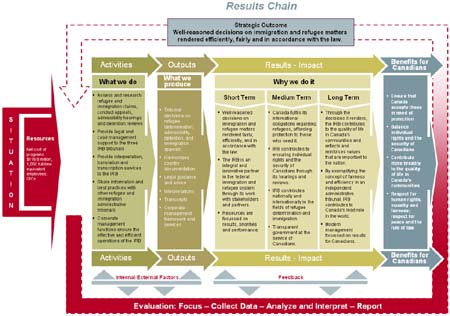
(Click on image to enlarge)
Total Financial and Human Resources
The IRB's three-year forecast for its total financial and human resources is as follows:
| Financial Resources ($ millions) | ||
| 2006-2007 | 2007-2008 | 2008-2009 |
| 116.8 | 113.7 | 113.7 |
| Human Resources (Full-time Equivalents) | ||
| 2006-2007 | 2007-2008 | 2008-2009 |
| 1,050 | 1,025 | 1,025 |
In support of the three-year forecast of total Financial Resources table, the IRB's financial resources allocation by program activity is as follows:
| Financial Resources Allocation by Program Activity ($ millions) |
|||
| Program Activity | 2006-2007 | 2007-2008 | 2008-2009 |
| Refugee Protection | 86.4 | 85.3 | 85.3 |
| Admissibility Hearings and Detention Reviews | 15.2 | 15.5 | 15.5 |
| Immigration Appeal | 15.2 | 12.9 | 12.9 |
| Corporate Management and Services |
— | — | — |
| Total | 116.8 | 113.7 | 113.7 |
| Human Resources (Full-time Equivalents) | 1,050 | 1,025 | 1,025 |
Note: The total Corporate Management and Services planned spending for 2006-2007 is $23.4 M and includes $13.5 M for personnel, $2.6 M for the Employee Benefit Plan (EBP) and $7.3 M for other operating expenditures. The amount of $23.4 M is proportionally reallocated to the other activities: $17.3 M to Refugee Protection, $3.1 M to Admissibility Hearings and Detention Reviews and $3.0 M to Immigration Appeal. The reallocation is based on respective budget expenditures trends. For 2007-2008 and 2008-2009, the total planned spending for Corporate Management and Services is $23.5 M per year and is proportionally reallocated to the other activities: $17.6 M to Refugee Protection, $3.2 M to Admissibility Hearings and Detention Reviews and $2.7 M to Immigration Appeal.
Working Environment
The IRB carries out its mandate within a complex and ever-changing environment. Both international and domestic factors can influence the Board's working environment and context. For example, conflicts and country conditions abroad can result in refugee movements, which in turn affect the number of refugee protection claims made in Canada. The same is true of unanticipated shifts in international patterns of migration, which can affect the number of people seeking admission to Canada.
Declining global refugee populations
Although people are still moving around the world, the number of displaced people and refugee claimants has generally declined. The most recent UNHCR figures available (January to March 2005) suggest that the downward trend observed in 2004 – when the global number of refugees reached an estimated 9.2 million, a 4 percent decrease from 2003 – continued in 2005.
This sustained global decline is due to many factors, including lasting solutions available to refugees, such as voluntary repatriation, a reduction in interstate conflicts, increasing stability in some fragile states, improved human rights conditions in some states, and an increased global focus on border protection and security.
In addition to the above factors, specific factors contributed to this decline in Canada:
- The implementation of visa requirements for selected countries
- The Canada Border Services Agency's prevention of undocumented or improperly documented travellers from coming to Canada
- The requirement, with some exceptions, under the Canada-United States Safe Third Country Agreement (December 2004) that refugee protection claimants travelling through the United States or Canada make their claim in the first country in which they arrive
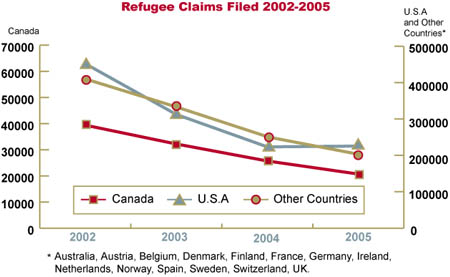
Top source countries
Latin American and Asian countries, specifically China, Colombia and Mexico, remained among the top source countries for refugee protection claims in Canada for the last fiscal year. This is due to a number of factors including growing political polarization in parts of Latin America, political unrest in Asia, slow or stagnant economic growth in Latin America, and lack of progress in the protection of women and/or children.
Changing workloads and domestic factors
In light of the changing workloads due to declining numbers of refugee protection claims and increased numbers of immigration appeals, the IRB is increasing its emphasis on an integrated approach to the management and processing of all its cases. Cases are becoming more complex, driven by mixed migration, broader grounds for protection, security concerns and fraudulent documentation.
Although the IRB continues to receive fewer refugee protection claims than in previous years and continues to make solid progress in finalizing more refugee protection claims awaiting determination, it is still working at reducing the inventory of claims waiting for a decision.
Growing trend of family sponsorships
Immigration continues to be very important for Canada, as immigrants represent an increasing part of the population. Canada's population of immigrants is expected to reach between 7 and 9.3 million by 2017.
In this context and given the Government of Canada's priority of promoting family reunification, family-class sponsorship applications have increased at Canadian visa posts around the world. As a result, the IRB continues to experience a high volume of family sponsorship appeals.
Regulation of immigration consultants
New regulations governing counsel who may appear before the Board came into effect in April 2004. These regulations are aimed at enhancing the quality of representation in IRB proceedings by requiring that any person who, for a fee, represents, advises or consults with a person who is the subject of a proceeding before the IRB be an authorized representative. During the past year, the IRB began the process of adapting its existing procedures to reflect this new requirement.
Modernization and accountability
Public interest in the work of the IRB continues, along with a greater demand for accountability and transparency in government. The IRB continues to respond to this demand by adopting more modern management practices and operations, continuing strategic and operational planning, reviewing performance measurements, and continuing to improve the quality, consistency and efficiency of its decision-making.
Merit-based GIC member selection process
Canadians increasingly expect high levels of competency and ethical conduct from those who hold public office. A merit-based approach to the appointment of senior officials in government is a significant way for federal institutions to demonstrate credibility. In March 2004, the Immigration and Refugee Board of Canada (IRB) implemented a selection process based on merit for IRB Governor-in-Council appointees. The ultimate power of appointments and reappointments remains with the Governor in Council. However, as the Chief Executive Officer, the Chairperson of the IRB is fully accountable for the selection and the quality of IRB's decision-makers.
This reform represents another step in the evolution of the processes to ensure the quality and effectiveness of decisions made by the IRB and to respond to the increasingly complex environment of the Board. The independent, transparent and merit-based selection process ensures that only highly qualified candidates are considered for appointment. The qualifications of candidates are measured against a new strengthened standard of competence to ensure that skills, abilities and personal suitability are the basis for the appointment.
The IRB acknowledges that performance evaluation is a fundamental instrument to support decisions for reappointment. The IRB member performance evaluation has been revised to reflect a performance evaluation and competency appraisal consistent with the new merit-based criteria. All current members have been and will continue to be appraised against the new standards.
The IRB's continued success in rendering fair and quick decisions depends on, among other things, timely appointments and reappointments of members.
Government-wide initiatives
The Government of Canada has launched an initiative to improve public sector management in order to respond to the present and emerging challenges that Canada faces. This plan, which will be implemented over several years, focuses on making government more accountable, responsive and innovative.
In line with the objective of strengthening public sector management, the IRB will continue to modernize and strengthen its management practices in order to enhance the organization's overall performance. The IRB intends to fulfil its mission by building an effective organizational capacity to sustain a high volume of decisions – specifically, by ensuring that the necessary infrastructure is in place in the areas of management, human resources, information technology and communications.
Modernizing human resources management and reinforcing its commitment to being a learning organization are two of the Board's ongoing priorities. In the Fall 2005, the IRB adopted a People Management Strategy as a framework to support priorities and initiatives related to its personnel. A major component of this framework, the Learning and Development Strategy, was also approved.
Portfolio Management
The IRB, CBSA and CIC collaborate on operational and portfolio matters, while respecting each other's distinct mandates and the independence of the functions of the tribunal. Relationships within the portfolio reflect strengthened efforts on issues relating to the overall management of the portfolio and take into account evolving case management initiatives designed to meet ongoing and diverse challenges.
The IRB and CIC have had a Memorandum of Understanding (MOU) in place since December 1996. The agreement clearly defines the administrative relationship between the two organizations, while underlining the institutional independence of the IRB and its decision-makers. The agreement facilitates workload management and the effective use of resources.
With the creation of the CBSA and the transfer to that organization of many enforcement functions formerly carried out by CIC, the IRB and the CBSA have negotiated a new MOU to define their relationship and reflect today's operational environment and priorities. The agreement is expected to be signed in 2006-2007. Flowing from this new MOU, priorities will be established to define sub-agreements. Also in 2006-2007 the IRB and CIC plan to review and update their MOU and the related sub-agreements to reflect these changes in the immigration and refugee portfolio.
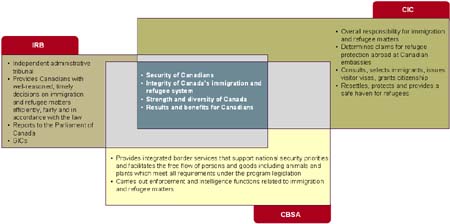
(Click on image to enlarge)
Partners and Agencies
The IRB also works closely with central agencies, for example, with the Privy Council Office on Governor-in-Council (GIC) appointments of IRB members and on regulatory initiatives, and with the Treasury Board Secretariat on program management and accountability. Furthermore, the IRB works with Public Works and Government Services Canada on procurement and accommodation issues, and with the Public Service Commission, Public Service Human Resources Management Agency of Canada and the Canada School of Public Service on human resources management issues.
The IRB continues to contribute to the annual conferences of the Council of Canadian Administrative Tribunals (CCAT). These meetings provide an opportunity for all Canadian administrative tribunals to share best practices and new approaches to emerging issues.
Stakeholders
The IRB's Consultative Committee on Practices and Procedures (CCPP) encourages systematic contact between the IRB and non-governmental stakeholders at the national level. The Committee is composed of representatives of the Canadian Council for Refugees (CCR), the Canadian Bar Association (CBA), the Refugee Lawyers Association (RLA), L'Association québécoise des avocats et des avocates en droit de l'immigration (AQAADI) and the United Nations High Commissioner for Refugees (UNHCR). The CCPP provides a forum for consultation, advice, information sharing and the resolution of issues of mutual concern regarding procedures and practices.
The IRB is building on efforts it has initiated over the past fiscal year to establish new and flexible mechanisms to enhance ongoing dialogue and to ensure that relationships continue to be responsive to evolving needs. This includes bilateral meetings with select organizations on specific issues.
Regional offices maintain relationships with their own regional stakeholders, including immigration consultants and bar associations, refugee and refugee law associations and NGOs.
International Context
The IRB actively participates in international intergovernmental and non-governmental organizations, which includes regular participation in three forums:
- The International Association of Refugee Law Judges (IARLJ)
- The Executive Committee of the United Nations High Commissioner for Refugees (EXCOM)
- The Intergovernmental Consultations on Asylum, Refugee and Migration Policies in Europe, North America and Australia (IGC)
The IRB has developed good relations with a number of refugee-receiving countries through the IGC network, and works with its counterparts in various states such as Australia, Mexico, New Zealand, Sweden, the United Kingdom, and the United States.
The IRB also participates in the European Union Network for Asylum Practitioners (Eurasil), and in Metropolis, an international forum for comparative research and public policy development about population migration, cultural diversity and immigrant integration in cities in Canada and around the world.
Alignment with Government of Canada outcomes
Canada's federal organizations play an important role in the quality of life of Canadians. All government policies, outcomes, departmental mandates and programs are directed at fulfilling this role. The IRB makes important contributions to a number of Government of Canada outcomes, which are highlighted in the following diagram.
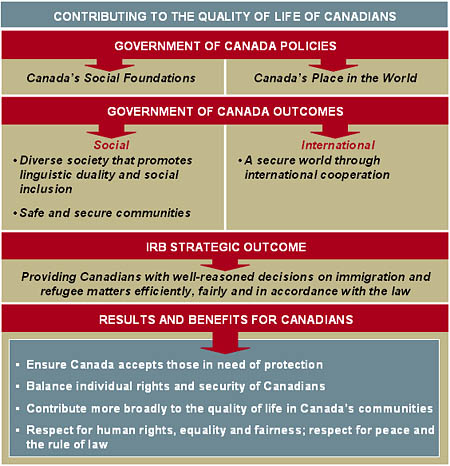
IRB Strategic Outcome, Strategic Priorities and Program Activities
This section provides information at the organizational level on the Board's strategic outcome, strategic priorities and program activities.
IRB Strategic Outcome
Based on its legislated mandate, the IRB's single strategic outcome is as follows:
To provide Canadians with well-reasoned decisions on immigration and refugee matters rendered efficiently, fairly and in accordance with the law.
IRB Strategic Priorities
To achieve its strategic outcome, the IRB has developed four strategic priorities for fiscal year 2006-2007. These contribute to the achievement of the IRB's strategic outcome by ensuring that the Board's plans (activities) and expected results emphasize high-quality, consistent and efficient measures across the organization, an open environment that values its people and promotes flexibility, accountability and continuous improvement.
| Strategic Priorities 2006-2007 |
| The Immigration and Refugee Board of Canada is an independent tribunal established by the Parliament of Canada. Our mission, on behalf of Canadians, is to make well-reasoned decisions on immigration and refugee matters, efficiently, fairly, and in accordance with the law. |
| Integrate common procedural, administrative and adjudicative activities in all divisions to further promote quality, consistency and efficiency measures. |
| Continue to build an organizational culture that supports its people, and is flexible and innovative. |
| Improve case management processes through the successful implementation of the Integrated Case Management System (ICMS). |
| Implement a horizontal and fully integrated management plan that reflects the IRB's reality. |
IRB Program Activities
For fiscal year 2006-2007, the IRB has developed an Integrated Business Plan, which brings together the plans and expected results for the Board's four program activities. It outlines how each program activity will contribute to the achievement of the IRB's strategic priorities in the next fiscal year. These plans and expected results are presented in Section 2.
To further strengthen accountability and transparency within the organization, the IRB's Integrated Business Plan was developed in close alignment with the Government of Canada's commitment to modernization and continuous improvement, based on the themes of accountability, responsiveness and innovation. The implementation of these management initiatives is crucial to delivering results for Canadians and achieving our strategic outcome.
Estimated Financial Resources by Strategic Priority
The IRB's four main program activities (Refugee Protection, Admissibility Hearings and Detention Reviews, Immigration Appeal, and Corporate Management and Services) are carried out with the goal of achieving the IRB's strategic priorities and strategic outcome. The following table outlines the estimated financial resources for each strategic priority over next three fiscal years.
| Estimated Financial Resources by Strategic Priority | |||
| Strategic Outcome: To provide Canadians with well-reasoned decisions on immigration and refugee matters rendered efficiently, fairly and in accordance with the law. | |||
| Planned Spending ($ millions) | |||
| Strategic Priority | 2006-2007 | 2007-2008 | 2008-2009 |
| 1. Integrate common procedural, administrative and adjudicative activities in all Divisions to further promote quality, consistency and efficiency measures | 87.7 | 90.5 | 90.5 |
Expected Results
|
|||
| Type: Previously committed | |||
| Program Activity: Refugee Protection, Admissibility Hearings and Detention Reviews, Immigration Appeal, Corporate Management and Services | |||
| 2. Continue to build an organizational culture that supports its people, and is flexible and innovative | 1.4 | 1.4 | 1.4 |
Expected Results
|
|||
| Type: Ongoing | |||
| Program Activity: Refugee Protection, Admissibility Hearings and Detention Reviews, Immigration Appeal, Corporate Management and Services | |||
| 3. Improve case management processes through the successful implementation of the Integrated Case Management System (ICMS) | 9.5 | 3.5 | 3.5 |
Expected Results
|
|||
| Type: Ongoing | |||
| Program Activity: Refugee Protection, Corporate Management and Services | |||
| 4. Implement a horizontal and fully integrated management plan that reflects the IRB's reality | 18.2 | 18.3 | 18.3 |
Expected Results
|
|||
| Type: Ongoing | |||
| Program Activity: Corporate Management and Services | |||
Section 2: Detailed Analysis of Program Activities
As noted in Section 1, the IRB has developed an Integrated Business Plan for 2006-2007. A key part of this plan is the identification of the areas of activities (plans) that are common to the four program activities and that contribute to achieving the strategic priorities set out for the next fiscal year. The plans and expected results associated with these common elements are primarily aimed at achieving the IRB's first two strategic priorities, and are presented in the table below.
Common Elements:
Plans and Expected Results for 2006-2007
| Strategic Outcome: Provide Canadians with well-reasoned, timely decisions on immigration and refugee matters efficiently, fairly and in accordance with the law. | |
| STRATEGIC PRIORITY Integrate common procedural, administrative and adjudicative activities in all Divisions to further promote quality, consistency and efficiency measures |
|
| Plans | Expected Results |
| Policy Instruments and Procedures | |
| Develop policies and procedures on dealing with Vulnerable Persons |
|
| Develop a standardized approach to how the IRB deals with cases involving non-disclosure of information (S.86 cases) |
|
| Elaboration of IRB detention/security framework and implementation of selected elements across the Divisions |
|
| Initiate the development of a common/shared policy on the use of videoconferencing |
|
| Performance Measures | |
| Initiate a standardized approach to present IRB performance indicators, including meaningful cross-divisional indicators, both quantitative and qualitative |
|
| Adjudicative Culture | |
| Develop and implement IRB common guidelines and procedures in relation to counsel conduct |
|
| STRATEGIC PRIORITY Continue to build an organizational culture that supports its people, and is flexible and innovative |
|
| Plans | Expected Results |
| Continue to implement a competency-based HR management strategy across the IRB, including developing competency profiles for functional groups and tools to support their use |
|
| Implement policy on redeployment between the RPD and IAD allowing increased mobility between Divisions |
|
| Cross-training between Divisions and joint training and professional development in place where appropriate |
|
| Provide strategic communications advice and information that reflect changes to procedural, administrative and adjudicative activities |
|
| International | |
| Within the International Program, Divisions and Operations to define respective international priorities |
|
| Coordinate international conference participation |
|
| Linkage with Government Agenda | ||
| Responsiveness | Innovation | Accountability |
The IRB Integrated Business Plan also identifies the elements, tribunal values, operations, and corporate management and services that are distinct to each program activity and that will contribute to realizing our strategic priorities for 2006-2007. These are highlighted in the following detailed analysis.
Refugee Protection Program Activity
The Refugee Protection Division delivers the IRB's refugee protection program activity, and continues to play a pivotal role in enabling the Board to achieve its strategic priorities. A major share of IRB resources are committed to this program activity, which is focused on rendering quality decisions in a consistent, timely manner on refugee protection claims made in Canada.
| Financial Resources ($ millions) | ||
| 2006-2007 | 2007-2008 | 2008-2009 |
| 86.4 | 85.3 | 85.3 |
| Human Resources (Full-time Equivalents) | ||
| 2006-2007 | 2007-2008 | 2008-2009 |
| 825 | 815 | 815 |
The difference in the financial resources and FTE figures for 2006-2007 and 2007-2008 is due mainly to the end of the temporary funding of $2.0 million relating to administrative measures in support of refugee reform within the Refugee Protection program activity.
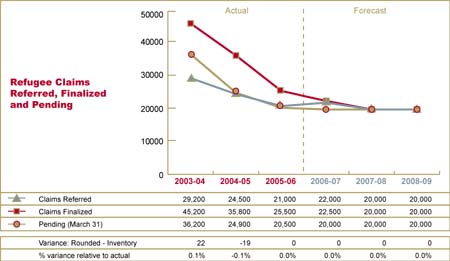
(Click on image to enlarge)
2006-2007 Outlook
For fiscal year 2006-2007, the Refugee Protection Division expects that it will receive approximately 22,000 new claims, 5 percent more than in fiscal year 2005-2006.
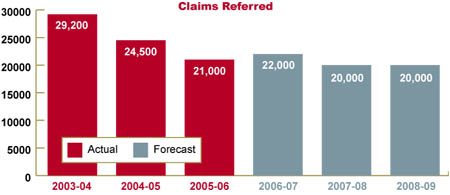
In 2006-2007, the Refugee Protection Division expects to finalize 22,500 cases, 12 percent less than in fiscal year 2005-2006. A continued downward trend of finalizations is anticipated, attributable to a reduced flexibility to schedule hearings and a continued focus on addressing a higher proportion of older, complex and time-consuming cases due to success in finalizing relatively simple, straightforward cases from the inventory.
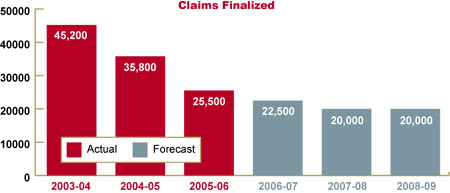
Based on 22,500 claim finalizations, the average cost per claim is expected to be $3,500 for 2006-2007. Unit costs per claim range from $1,300 for an expedited case to $4,400 for complex cases. The projected overall average cost per claim of $3,500 is higher than the 2004-2005 actual average cost of $2,500 per claim. In 2004-2005, there were 35,800 claims finalized. The increase in cost per claim is mainly attributable to increases in salaries and funding for reforms to the refugee determination system, changes in the case mix as a larger share of complex cases are being projected for finalization thus requiring longer hearings, a higher share of fixed costs per unit caused by a drop in volume as well as transition costs associated with reductions in business volumes and required staffing levels.
The cost per claim includes the decision-making costs and costs of related activities such as case preparation, research, scheduling of hearings, legal services, foreign-language interpretation, technological support, translation services, as well as administrative support but it excludes extraordinary items such as the ICMS project development costs. It also includes a share of the costs from the corporate management and services program activity, which is allocated to the three decision-making program activities, based on expenditure trends.
Due to past success in reducing the inventory of claims pending (waiting for a decision), increased resources and improvements in case management processes, the Division is positioned to reduce its inventory to approximately 20,000 claims pending by the end of the 2006-2007 fiscal year, if appointments and re-appointments of decision-makers are made in a timely way.
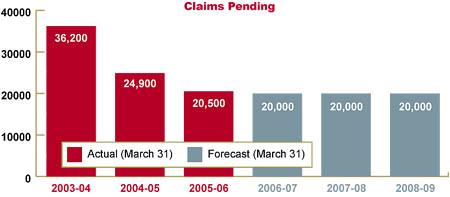
The average processing time continues to drop, and the Division anticipates achieving an 11-month average processing time for the next fiscal year. This is contingent on receiving and maintaining the required level of decision-makers. The Division continues its efforts to seek efficiencies in case processing activities, with a view to decreasing the average processing time.
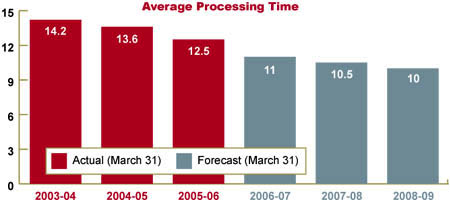
Key Plans and Expected Results
To achieve its forecasts for fiscal year 2006-2007, and in line with the strategic priorities set out for the organization, the refugee protection program activity will undertake the planned activities with the expected results outlined in the following table.
Program Activity: Refugee Protection
Plans and Expected Results for 2006-2007
| Strategic Outcome: Provide Canadians with well-reasoned, timely decisions on immigration and refugee matters efficiently, fairly and in accordance with the law. | |
| STRATEGIC PRIORITY Integrate common procedural, administrative and adjudicative activities in all Divisions to further promote quality, consistency and efficiency measures |
|
| Plans | Expected Results |
| Distinct Elements and Tribunal Values | |
| Further monitoring of RPD Action Plan in order to ensure implementation |
|
| Pursue measures to further streamline RPD processes |
|
| Further reduce pending inventory, processing times and cost by claim by monitoring and expanding Fast Track Initiative, reducing adjournments and postponements, and through more sophisticated streamlining |
|
| Continue to implement and monitor the strategic approach to quality decision-making through quality issue sessions, discussion groups, additional National Documentation Packages, Jurisprudential Guides and Persuasive Decisions, as needed, and Guidelines for Vulnerable Persons |
|
| Facilitate the process of making appointments and re-appointments in a timely way |
|
| Training developed and delivered on various topics including state protection, delivery of reasons, exclusion and Vulnerable Persons Guidelines |
|
| Review and deliver new member training, and deliver focus training for experienced members in all areas identified by RPD |
|
| STRATEGIC PRIORITY Improve case management processes through the successful implementation of ICMS |
|
| Plans | Expected Results |
| ICMS Operations | |
| Development and implementation of Release 4 |
|
| Delivery of required training and simulation exercise |
|
| Post-implementation evaluation focusing on "lessons learned" carried out |
|
| Linkage with Government Agenda | ||
| Responsiveness | Innovation | Accountability |
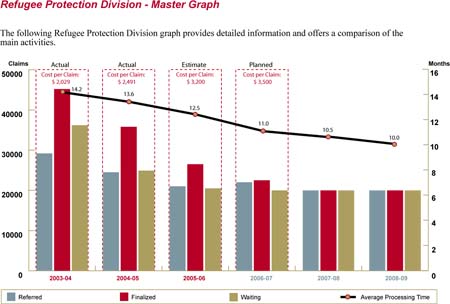
(Click on image to enlarge)
Admissibility Hearings and Detention Reviews Program Activity
The Immigration Division delivers the IRB's admissibility hearing and detention review program activity. Admissibility hearings are held for foreign nationals or permanent residents who are alleged to be inadmissible to Canada pursuant to the provisions of IRPA. Detention reviews are held concerning permanent residents and foreign nationals who are detained under IRPA authority, and must be conducted within specific timeframes set out in IRPA. Decision-makers must balance the rights of individuals to liberty with the security interests of Canadians and persons in Canada. The number of admissibility hearings and detention reviews conducted by the IRB depends on the number of cases referred to it by CBSA and CIC.
| Financial Resources ($ millions) | ||
| 2006-2007 | 2007-2008 | 2008-2009 |
| 15.2 | 15.5 | 15.5 |
| Human Resources (Full-time Equivalents) | ||
| 2006-2007 | 2007-2008 | 2008-2009 |
| 90 | 90 | 90 |
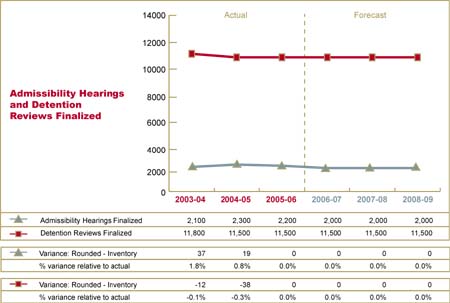
(Click on image to enlarge)
2006-2007 Outlook
The Immigration Division anticipates that the volume of admissibility hearings will remain stable, and expects that 2,000 admissibility hearings will be finalized in 2006-2007. The number of cases being referred to the Division has declined since IRPA was implemented. However, the proportion of complex cases involving war crimes, organized crime, terrorism, transnational crime and foreign criminality has increased.
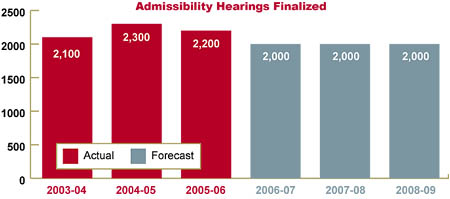
The number of detention reviews conducted by the Immigration Division has also remained stable. The Division anticipates that it will finalize approximately 11,500 detention reviews in 2006-2007. An important factor in detention reviews, criminality is an element that is present in a high proportion of cases, particularly those that involve long-term detention.
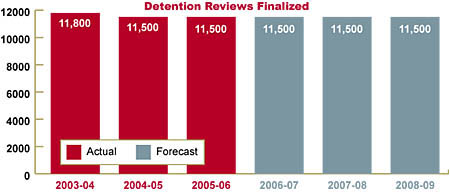
Based on 2,000 admissibility hearings and 11,500 detention reviews, the average cost per admissibility hearing and detention review is expected to be $1,100 and $800, respectively for 2006-2007. These average costs are slightly higher than the 2004-2005 actual average costs, due mainly to increases in salaries and a higher share of fixed costs per unit caused by a slight drop in the projected
The costs per admissibility hearing and detention review include decision-making costs and costs of related activities such as case preparation, scheduling of hearings, legal services, foreign-language interpretation, technological support, translation services, transcribing services, as well as administrative support but it excludes extraordinary items such as the ICMS project development costs. It also includes a share of the costs from the Corporate Management and Services program activity, which is allocated to the three decision-making program activities, based on expenditure trends.
Key Plans and Expected Results
To achieve its forecasts for fiscal year 2006-2007, and in line with the strategic priorities set out for the organization, the admissibility hearings and detention reviews program activity will undertake the planned activities with the expected results outlined in the following table.
Program Activity: Admissibility Hearings
and Detention Reviews
Plans and Expected Results for 2006-2007
| Strategic Outcome: Provide Canadians with well-reasoned, timely decisions on immigration and refugee matters efficiently, fairly and in accordance with the law. | |
| STRATEGIC PRIORITY Integrate common procedural, administrative and adjudicative activities in all Divisions to further promote quality, consistency and efficiency measures |
|
| Plans | Expected Results |
| Distinct Elements and Tribunal Values | |
| Develop harmonized and informal processes to help meet the legislative timeframes and operational requirements to achieve finalization of all cases referred by CBSA and CIC |
|
| Building on the best business practices of IRB, the Immigration Division will introduce and implement innovative approaches to its processes |
|
| Further develop, maintain and promote tools that will support quality, consistency and efficiency in decision-making in the areas of ethics, communications, quality control, and service delivery |
|
| Continue to monitor retirements in order to identify staffing requirements |
|
| Deliver focused and quality training on an ongoing basis in order to meet ID members' specific training needs and address emerging issues (including terrorism, organized crime, etc.) |
|
| Continue to implement learning culture and develop training tools |
|
| Linkage with Government Agenda | ||
| Responsiveness | Innovation | Accountability |
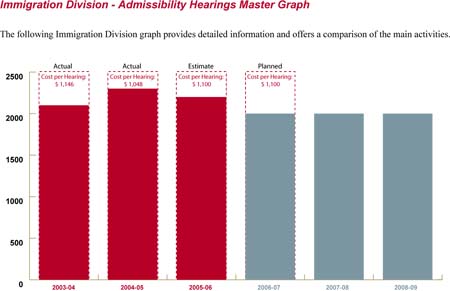
(Click on image to enlarge)
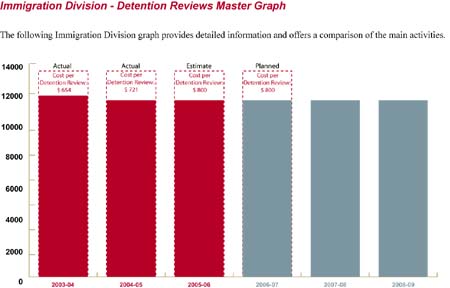
(Click on image to enlarge)
Immigration Appeal Program Activity
The Immigration Appeal Division delivers the IRB's immigration appeal program activity. It hears immigration appeals from Canadian citizens and permanent residents whose applications to sponsor close family members to Canada have been refused. Other key functions include hearing appeals from permanent residents, foreign nationals with a permanent resident visa, and protected persons who have been ordered removed from Canada, as well as from permanent residents outside of Canada who have not fulfilled their residency obligation.
| Financial Resources ($ millions) | ||
| 2006-2007 | 2007-2008 | 2008-2009 |
| 15.2 | 12.9 | 12.9 |
| Human Resources (Full-time Equivalents) | ||
| 2006-2007 | 2007-2008 | 2008-2009 |
| 135 | 120 | 120 |
The difference in the financial resources and FTE figures for 2006-2007 and 2007-2008 is due mainly to the end of the temporary funding of $1.9 million to address short-term pressures to reduce the inventory of sponsored family-class applications in the Immigration Appeal program activity.

(Click on image to enlarge)
2006-2007 Outlook
The Immigration Appeal Division expects the high level of new appeals to continue. In fiscal year 2006-2007, the Division anticipates 6,500 appeals will be filed, which is a volume consistent with the number of appeals received over the last two years.
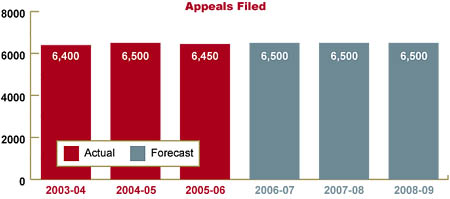
Approximately 6,500 appeals are expected to be finalized, representing an increase of 18 percent over the previous fiscal year. However, the level of finalizations is contingent on the level of resources, as well as on the effective implementation of major changes in the way that appeals are processed. Some of these changes require cooperation or additional resources from CBSA and CIC. The organization will continue to pursue effective internal communications and promote public service values and ethics.
In 2006-2007, the IAD will work on a fundamental transformation of the way it conducts its work through the IAD Innovation initiative, which was launched in September 2005. Also, the complement of IAD members and staff is expected to increase in the next fiscal year as a means of increasing the capacity of the Division.
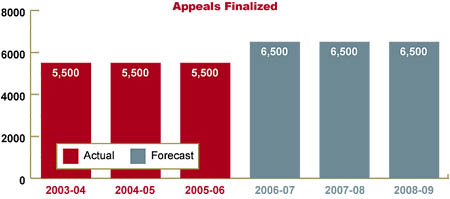
Based on 6,500 appeal finalizations, the average cost per appeal is expected to be $2,100 for 2006-2007. The average cost per appeal is slightly higher than the 2004-2005 actual average cost per appeal due mainly to increases in salaries.
The cost per appeal includes the decision-making costs and costs of related activities such as case preparation, scheduling of hearings, legal services, technological support, translation services, as well as administrative support but it excludes extraordinary items such as the ICMS project development costs. It also includes a share of the costs from the Corporate Management and Services program activity, which is allocated to the three decision-making program activities, based on expenditure trends.
Based on the Division's consistently high productivity and the expected increase in capacity in 2006-2007, the Division will be in a strong position to match the expected intake, preventing a further increase in pending inventory.
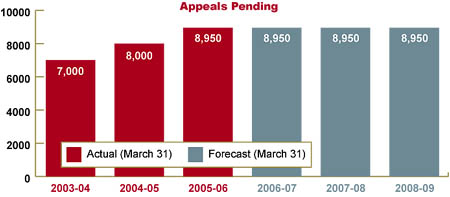
Despite sustained high productivity through case management innovations, the average processing time is expected to be 10 months for fiscal year 2006-2007. Reducing the average processing time is contingent on maintaining an adequate level of resources and effective implementation of the major changes in the IAD Innovative initiative.
Key Plans and Expected Results
To achieve its forecasts for fiscal year 2006-2007, and in line with the strategic priorities set out for the organization, the immigration appeal program activity will undertake the planned activities with the expected results outlined in the following table.
Program Activity: Immigration Appeal
Plans and Expected Results for 2006-2007
| Strategic Outcome: Provide Canadians with well-reasoned, timely decisions on immigration and refugee matters efficiently, fairly and in accordance with the law. | |
| STRATEGIC PRIORITY Integrate common procedural, administrative and adjudicative activities in all Divisions to further promote quality, consistency and efficiency measures |
|
| Plans | Expected Results |
| Distinct Elements and Tribunal Values | |
| Review Alternative Dispute Resolution (ADR) practices and procedures, and case selection |
|
| Expand and improve early review process |
|
| Facilitate the process of making appointments and re-appointments in a timely way |
|
| Develop innovative approach to obtain more information from both parties earlier, to support earlier screening, streaming and resolution |
|
| Members take more proactive control of the hearing process – more limits on issues, questioning, evidence, submissions (relevance), more interventions by members |
|
| Analyze nature and scope of adjournments and postponements; and develop action plans to reduce the postponement/adjournment rate |
|
| Review ADR in-house training |
|
| Develop customized training plan for new members (if necessary) |
|
| Linkage with Government Agenda | ||
| Responsiveness | Innovation | Accountability |
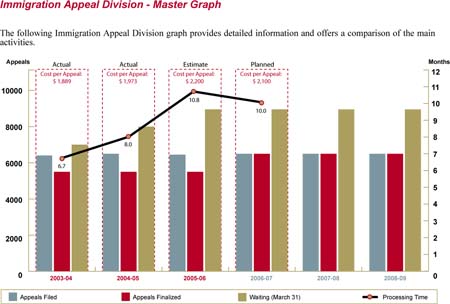
(Click on image to enlarge)
Corporate Management and Services Program Activity
The corporate management and services program activity provides important infrastructure to support the IRB's decision-making function as an effective, accountable, efficient operation, and to implement government-wide management and improvement initiatives. The IRB continues to make significant commitments to provide decision-makers with up-to-date and innovative management practices, infrastructure tools and resources in order to sustain a high volume of quality decisions at the Board.
The corporate management and services program activity at the IRB encompasses executive offices, planning, finance, administration, communications, human resources, legal services, information management and information technology.
As noted in Section 1, the planned spending and FTEs for corporate management and services are proportionally allocated to the three decision-making program activities.
Key Plans and Expected Results
In line with the strategic priorities set out for the organization, the corporate management and services program activity will undertake the planned activities with the expected results outlined in the following table.
Program Activity: Corporate Management and Services
Plans and Expected Results for 2006-2007
| Strategic Outcome: Provide Canadians with well-reasoned, timely decisions on immigration and refugee matters efficiently, fairly and in accordance with the law. | |
| STRATEGIC PRIORITY Improve case management processes through the successful implementation of ICMS |
|
| Plans | Expected Results |
| Corporate Management and Services | |
| Provide on-going maintenance of ICMS applications once implemented |
|
| Transition ICMS IT resources, tools, procedures and infrastructure to the IS Directorate |
|
| Implement a change management strategy with respect to the ICMS project that includes comprehensive communications and training plans |
|
| STRATEGIC PRIORITY Implement a horizontal and fully integrated management plan that reflects the IRB's reality |
|
| Plans | Expected Results |
| Corporate Planning and Accountability | |
| Update the Risk Management Plan to reflect strategic priorities, the Government Management Agenda and implement the Legal Risk Management System |
|
| Provide effective financial planning and budgeting using ABB, A-Base Reviews and other tools to support resourcing process within IRB |
|
| Develop an HR Planning tool to facilitate the integration of HR Planning in business planning |
|
| Audit and Evaluation | |
| Update the 3-year action plan to bring the IRB into compliance with the new internal audit policy |
|
| People Management | |
| Implement identified priorities of the People Management Strategy, including the implementation of an integrated learning and professional development program for all IRB personnel |
|
| Implement HR Modernization measures and objectives including those related to compliance with the new PSLRA and PSMA |
|
| Receive and analyze PSES results, and develop an action plan to address the results |
|
| Revise the GIC recruitment process to ensure further alignment with the Member Competency Profile, including revisions to the screening test and interview guide for GIC recruitment |
|
| Examine the possibility of the development of a unique classification standard for the IRB |
|
| Financial Management | |
| Implement formal management monitoring function |
|
| Security | |
| Implement a comprehensive security program that includes a Business Continuity Plan updated annually and the implementation of the Management Information Technology Security (MITS) Action Plan |
|
| Procurement and Asset Management | |
| Implement a comprehensive procurement and asset management program |
|
| Development of appropriate contracting regimes and controls on interpreter file |
|
| Information Management | |
| Implement the relevant elements of the Information Management (IM) action plan following the IM Capacity exercise |
|
| Using Infonet, provide all employees with authoritative, comprehensive and well-structured information in support of their respective operational goals and obligations |
|
| Information Systems | |
| Support IRB's activities with the appropriate infrastructure, desktop and network environment |
|
| Support all Systems users (external and internal) effectively and in accordance with service standards |
|
| Linkage with Government Agenda | ||
| Responsiveness | Innovation | Accountability |
Section 3: Supplementary Information
Responsibilities
Chairperson
The Chairperson is the IRB's Chief Executive Officer, senior decision-maker and spokesperson. Providing overall leadership and direction to the Board's three decision-making divisions, the Chairperson is responsible for creating and promoting a vision of the IRB that unifies all IRB personnel around the common purpose of making timely and just decisions on immigration and refugee matters.
In addition to the broad responsibility of the management of Governor-in-Council appointees, the Chairperson has a range of statutory powers at his disposal to provide assistance to decision-makers in order to enhance the quality, consistency and efficiency of decision-making. The Chairperson is accountable to Parliament and reports to it through the Minister of Citizenship and Immigration.
Executive Director
The Executive Director is the IRB's Chief Operating Officer and reports to the IRB Chairperson. The Executive Director is responsible for IRB operations and the administration of the Board's three decision-making divisions. The Executive Director is also responsible for approximately 900 public servants, including those who provide direct support to decision-making activities at the IRB.
Senior Management
Two Deputy Chairpersons (appointed by the Governor-in-Council) and one Director General (appointed under the Public Service Employment Act) oversee the decision-making in the three divisions. Four Directors General and a Senior General Counsel (all appointed under the Public Service Employment Act) are responsible for the corporate management and services functions, operations of the IRB, and legal services.
IRB Organization Chart
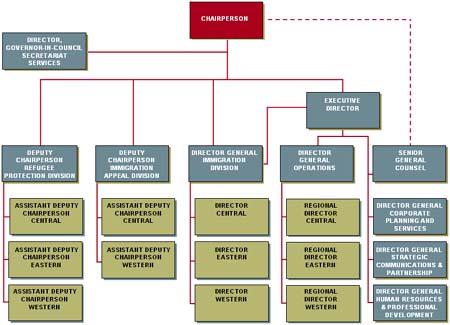
(Click on image to enlarge)
Table 1: Departmental Planned Spending and Full-Time Equivalents
This table shows the IRB's forecasted spending for 2005-2006, as well as the planned spending and full-time equivalents for the fiscal years 2006-2007, 2007-2008 and 2008-2009.
| ($ millions) | Forecast Spending 2005-2006 | Planned Spending 2006-2007 | Planned Spending 2007-2008 | Planned Spending 2008-2009 |
| Refugee Protection | 84.5 | 86.8 | 85.3 | 85.3 |
| Admissibility Hearings and Detention Reviews | 14.9 | 15.3 | 15.5 | 15.5 |
| Immigration Appeal | 12.6 | 15.3 | 12.9 | 12.9 |
| Budgetary Main Estimates (gross) | 112.0 | 117.3 | 113.7 | 113.7 |
| Less: Respendable revenue | ||||
| Total Main Estimates | 112.0 | 117.4 | 113.7 | 113.7 |
| Adjustments: | ||||
| Governor General Special Warrants: | ||||
| 1. Compensation for collective agreements | 4.0 | |||
| 2. Reforms to Refugee Determination System | 1.8 | |||
| 3. Operating budget carry forward | 0.8 | |||
| Budget Announcements: | ||||
| 1. Procurement savings | (0.1) | (0.5) | ||
| Other | ||||
| 1. Employee Benefit Plan (EBP) | 1.0 | |||
| Total Adjustments | 7.5 | (0.5) | ||
| Total Planned Spending | 119.5 | 116.8 | 113.7 | 113.7 |
| Total Planned Spending | 119.5 | 116.8 | 113.7 | 113.7 |
| Plus: Cost of services received without charge | 20.5 | 19.5 | 19.3 | 19.3 |
| Net cost of Program | 140.0 | 136.3 | 133.0 | 133.0 |
| Full Time Equivalents (FTEs) | 1,060 | 1,050 | 1,025 | 1,025 |
Due to rounding, figures may not add up to totals shown.
The variance between the 2005-2006 Forecast Spending and Planned Spending in 2006-2007 is $2.7 million. The overall decrease is mainly due to:
- A decrease of $3.5 million in temporary funding for the development of the Integrated Case Management System (ICMS)
- An increase of $1.9 million in temporary funding to address short-term pressures to reduce the inventory of sponsored family-class applications in the Immigration Appeal program activity
- An increase of $0.9 million in compensation for collective agreements
- A decrease of $0.8 million relating to the Operating budget carry forward provision for 2005-2006 as requested in the Governor General Special Warrants
- A decrease of $0.7 million to adjust the Employee Benefit Plan (EBP) factor from 20 percent to 19 percent
- A decrease of $0.5 million in 2006-2007 related to procurement savings
The difference in the planned spending for 2006-2007 and 2007-2008 is due mainly to the end of the temporary funding of $3.9 million of which $2.0 million relates to administrative measures in support of refugee reform within the Refugee Protection program activity and $1.9 million relates to the short-term pressures to reduce the inventory of family-class applications in the Immigation Appeal program activity; offset by the 2006-2007 procurement savings reduction.
Table 2: Program by Activity
The table below presents information on how the IRB plans to spend its resources by decision-making program activities in the next fiscal year.
| 2006-2007 | ||||||||||
| Budgetary ($ millions) | Non-Budge- tary |
|||||||||
| Program Activity | Oper- ating |
Capital | Grants and Contri- butions |
Gross | Revenue | Net | Loans, Invest- ments and Advan- ces |
Total Main Estim- ates |
Adjust- ments (planned spending not in Main Estim- ates) |
Total Planned Spending |
| Refugee Protection | ||||||||||
| 86.8 | 86.8 | 86.8 | 86.8 | (0.3) | 86.4 | |||||
| Admissibility Hearings and Detention Reviews | ||||||||||
| 15.3 | 15.3 | 15.3 | 15.3 | (0.1) | 15.2 | |||||
| Immigration Appeal | ||||||||||
| 15.3 | 15.3 | 15.3 | 15.3 | (0.1) | 15.2 | |||||
| Total | 117.4 | 117.4 | 117.4 | 117.4 | (0.5) | 116.8 | ||||
Due to rounding, figures may not add up to totals shown.
Table 3: Voted and Statutory Items Listed in Main Estimates
This table shows the way Parliament votes resources to the IRB, and essentially replicates the summary table listed in the Main Estimates. Resources are presented to Parliament in this format. Parliament approves the voted funding and the statutory information is provided for information purposes.
| 2006-2007 | |||
| Voted or Statutory Items ($ millions) |
Vote Wording | Current Main Estimates | Previous Main Estimates |
| 10 | Program Expenditures | 103.3 | 98.6 |
| (S) | Contributions to employee benefit plans | 14.1 | 13.4 |
| Total | 117.4 | 112.0 | |
Table 4: Services Received Without Charge
The table below presents information on the IRB's services received without charge from other government departments for the next fiscal year.
| 2006-2007 | |
| ($ millions) | |
| Accommodation provided by Public Works and Government Services Canada (PWGSC) | 13.9 |
| Contributions covering employers' share of employees'
insurance premiums and expenditures paid by Treasury Board of Canada Secretariat (excluding revolving funds) Employer's contribution to employees' insured benefits plans and expenditures paid by TBS |
5.6 |
| 2006-2007 Services received without charge | 19.5 |
Table 5: Resource Requirements by Organization and Decision-making Activity
This table shows how the IRB plans to spend its resources at the organization level and decision-making activities in the next fiscal year.
| 2006-2007 ($ millions) | ||||
| Organization | Refugee Protection | Admissibility Hearings and Detention Reviews | Immigration Appeal | Total Planned Spending |
| Chairperson, Executive Director and
Secretariat (including Governor-in-Council salaries) |
||||
| 24.6 | 0.2 | 4.6 | 29.4 | |
| Refugee Protection Division | ||||
| 1.2 | 1.2 | |||
| Immigration Appeal Division | ||||
| 0.9 | 0.9 | |||
| Immigration Division | ||||
| 4.0 | 4.0 | |||
| Strategic Communications and
Partnership (including special purpose account for the translation of decisions) |
||||
| 6.0 | 5.4 | 2.8 | 14.2 | |
| Human Resources and Professional Development | ||||
| 3.3 | 0.4 | 0.4 | 4.1 | |
| Legal Services | ||||
| 4.3 | 0.2 | 0.2 | 4.7 | |
| Corporate Planning and Services | ||||
| 6.9 | 1.2 | 1.2 | 9.3 | |
| Operations (including regions and ICMS) |
||||
| 40.1 | 3.8 | 5.1 | 49.0 | |
| Total | 86.4 | 15.2 | 15.2 | 116.8 |
Table 6: Integrated Case Management System Project (ICMS) *
The scope of this project is to improve case management by streamlining and automating business processes within the IRB and to implement an integrated case management system that will support IRB operations. ICMS will provide IRB employees with access to all information required to manage or work with IRB cases. ICMS will provide the IRB with the capacity to automate its case processing improvements, and to:
- Improve processing time
- Reduce backlog and overall cost of processing refugee cases
- Promote a consistency in decisions that will enhance the protection of refugees and the overall security of Canadians
- Increase security and integrity of the data
- Improve the current IT infrastructure
*Although ICMS does not meet the Treasury Board Secretariat definition of a major project for reporting purposes, it represents a significant investment for the IRB.
| Current Estimated Total Cost |
Cumulative Spending to March 31, 2005 |
Forecast Spending 2005-2006 |
Planned Spending 2006-2007 |
| ($ millions) | |||
| 40.0 | 24.1 | 8.9 | 7.0 |
On May 30, 2003, the IRB obtained the Effective Project Approval (EPA) for the implementation of the Integrated Case Management System (ICMS). On May 23, 2005, an amended EPA was approved to adjust the total estimated cost from $33.0 million to $37.0 million. An amended EPA was approved in June 2006 to increase EPA authority from $37.0 million to $40.0 million.
| Plans | Expected Results |
| Stage 1 | |
| Release 1: Replace the current Claim Type Management System and automate screening and streamlining activities | More robust system that will improve the IRB's case
management — Implemented June 2004 |
| Release 2: Automate research processes | Increased the effectiveness of the research processes by the
automation of the research requests — Implemented April 2005 |
| Release 3: Create Electronic Personal Information Form (e-PIF) | Enhanced client services by allowing Counsels to send PIFs
electronically — Implemented May 2005 |
| Release 4: Automation of the Refugee Protection Division (RPD) processes | Delivering the program through automating functions and
improving the quality and consistency of decision-making by providing timely, integrated, comprehensive and accurate
information on cases — Implemented May 2005 |
| Stage 2 | |
| Automate Immigration Appeal Division (IAD) processes | Building on Stage 1, development of the various ICMS elements required to provide actual appeal processing and scheduling for the IAD. (Under review pending business rationalization of IAD processes.) |
| Stage 3 | |
| Automate Immigration Division (ID) processes | Building on Stage 2, development of the various ICMS elements required to provide actual appeal processing and scheduling for the ID. (Under review pending business rationalization of ID processes.) |
Table 7: Internal Audits and Evaluations
The IRB has an active Internal Audit and Evaluation function that supports the delivery of independent, objective and strategically focused audit and evaluation products. The findings and recommendations flowing from internal audits and evaluations are a primary source of evidence for both strategic and operational decision-making and broader assurance purposes.
For 2006-2007, the IRB has drafted an ambitious Internal Audit and Evaluation plan that is rooted in program and strategic risk, as well as externally driven audit and evaluation requirements. The Internal Audit and Evaluation function of the IRB will also initiate the work of implementing the new government-wide Policy on Internal Audit.
| Plans | Expected Results |
| Cyclical Compliance Reviews | |
| Videoconferencing, Human Resources Strategy and Streamlining | Evidence-based assessment of management action taken on recommendations made in prior reviews/evaluations |
| Logic Model and Performance Measurement Framework | |
| IAD Innovation | Development and completion of the Logic Model and Performance Measurement Framework for the IAD Innovation |
| Values and Ethics Framework | Development and completion of the Logic Model and Performance Measurement Framework for the Values and Ethics Framework |
| Internal Audit | |
| Contracting Practices | Assurance that IRB contracting practices comply with TBS policy and identification of control weaknesses, if any |
| Control Self-Assessment | |
| MAF Element: Stage One | Three-year approach to ramp up for larger policy requirement to provide holistic assurance against key controls, as defined by the Office of the Comptroller General |
In 2005-2006 three reports were issued, each with an associated management response:
- Videoconferencing in Refugee Hearings (public release: May 2005)
- Review of the Human Resources Function (public release: May 2005)
- Formative Evaluation of the IRB's Streamlining Initiative (public release: January 2006)
Each of these reports and their associated management response and action plan can be found at the following link:
http://www.irb-cisr.gc.ca/en/about/transparency/evaluations/index-eng.htm
Section 4: Other Items of Interest
IAD Innovation
In recent years, the IRB has seen a substantial increase in the number of cases brought before its Immigration Appeal Division. This includes increases in sponsorship appeals (73 percent of the IAD caseload), removal order appeals and the new residency obligation appeals. Since 2002, the Division's annual intake has increased by 50 percent. In addition, the average processing time for appeals that are currently being finalized stands at almost ten months. At present, the IAD has almost 9,000 appeals in its pending inventory.
The increased volume of cases is indicative of a long-term trend for the Division rather than a passing or short-term spike. As Canada welcomes more immigrants, the IAD will likely face a higher volume of appeals and increased backlog, placing at risk public confidence in the appeal process.
Launch of IAD Innovation Initiative
Responding to the growing caseload, the IRB launched the IAD Innovation initiative on September 30, 2005. This follows the Chairperson's Action Plan, which first examined and transformed the processes of the Refugee Protection Division. The overall purpose of the action plans remains unchanged: to transform the IRB into a tribunal that resolves matters at the earliest possible opportunity and makes fair decisions in a simpler and faster way.
The IAD Innovation initiative entails a comprehensive re-examination of how the IAD works, including a re-thinking of all the processes by which it delivers justice. Following extensive internal and external consultations, the Chairperson released the IAD Innovation Plan on March 21, 2006. The Plan contained 26 proposals including:
- More proactive, more flexible and less court-like tribunal
- More information from the parties earlier in the process
- More effective screening and streaming of cases (triage and case management)
- More early resolution
- More proactive hearing, more focused and efficient, with issues and evidence identified at an early stage
- Integrate the work of specialized case management teams in the regions
- Members to develop an adjudication strategy to address a high volume of cases
While the IAD has a very good reputation among its stakeholders, the consultations have shown everyone isan openness to major changes. There is broad consensus that the IAD needs to take more control over its processes, that some appeals proceed unnecessarily to the hearing stage, and that members should take a more proactive role in the hearing room.
Impact
The IAD Innovation Plan seeks to ensure that the IAD can continue to deliver a high quality of justice simply, quickly and fairly, and in a manner that maximizes the opportunities for parties to resolve appeals without a hearing and within the shortest possible time.
The Board will engage in further consultation early in the fiscal year 2006-2007 before moving to the implementation planning stage and actual implementation. There will also be a short-term strategy to deal with the growing inventory of appeals.
Risk Management
The objective of IRB's integrated risk management framework is to increase the IRB's capacity to manage risk and integrate risk into priority setting, planning and other key decisions. IRB's executive team clearly defines the corporate context and practices for managing strategic and organizational risks proactively. By addressing risk within and throughout the normal planning phase, risk management represents not so much a new task, but rather a more structured way of doing what managers have been doing intuitively.
Risk is an active factor in decision-making processes at the Board, as evidenced by an executive committee assessment of corporate risks and the status of risk management (Corporate Risk Profile); an integrated risk management function with an organizational focus linked to corporate decision-making; protocols, processes and tools to ensure the application of risk management principles throughout the Board's decision-making and delivery; and, continuous organizational learning and lessons learned from risks identified and mitigated or not.
In 2006-2007, the IRB will:
- Prepare its annual Corporate Risk Profile
- Prepare its Internal Audit and Evaluation three-year risk-based plan
- Reposition the IRB risk management process in line with the Government of Canada's policy direction and government-wide approach
Business Continuity Planning
The IRB security program is governed by the policy directive to support the national interest and the Government of Canada's business objectives by safeguarding employees and assets, and assuring the continued delivery of services. The Treasury Board of Canada Secretariat (TBS) has established the requirements for comprehensive business continuity planning. The IRB's security priorities, therefore, are to protect people, information and assets, and to ensure the continued delivery of services. This imposes an obligation for business continuity planning, continuous risk management and IT disaster recovery planning.
In 2006-2007, the IRB will develop, test and assess its Business Continuity Plan (BCP) to ensure the Board's state of readiness to deal with possible disruptions of service. The IRB's overall readiness for recovering from service disruptions will also be evaluated. The BCP also includes a permanent maintenance cycle that encompasses ongoing review and revision of all plans to account for legislative and other changes, additional training, and regular testing and validation of all plans, including reports on lessons learned. The BCP will be incorporated, as appropriate, into the IRB's risk-based audit cycle as the basis of reporting to TBS and to Public Safety and Emergency Preparedness Canada.
Information and Contacts
Legislation Administered
Immigration and Refugee Protection Act
(S.C. 2001, c. 27, as amended)
Immigration and Refugee Protection Regulations
(SOR/2002-227, as amended)
Refugee Protection Division Rules
(SOR/2002-228)
Immigration Division Rules
(SOR/2002-229)
Immigration Appeal Division Rules
(SOR/2002-230)
Oath or Solemn Affirmation of Office Rules (Immigration and Refugee Board of Canada)
(SOR/2002-231)
IRB Processes
Visit these websites to find out how the IRB tribunal processes its cases:
- Process for Making a Claim for Refugee Protection
http://www.irb-cisr.gc.ca/en/references/procedures/processes/rpd/rpdp-eng.htm - Admissibility Hearing Process
http://www.irb-cisr.gc.ca/en/references/procedures/processes/id/ahp-eng.htm - Detention Review Process
http://www.irb-cisr.gc.ca/en/references/procedures/processes/id/drp-eng.htm - Sponsorship Appeal Process
http://www.irb-cisr.gc.ca/en/references/procedures/processes/iad/sap-eng.htm - Removal Order Appeal Process
http://www.irb-cisr.gc.ca/en/references/procedures/processes/iad/roap-eng.htm
Related Information
UNHCR website: http://www.unhcr.org/cgi-bin/texis/vtx/home
Contact us
For more information, visit the IRB website at
http://www.irb-cisr.gc.ca or contact the IRB Communications Directorate at
(613) 947-0803 or contact one of the IRB offices listed below.
National Headquarters
Immigration and Refugee Board
Minto Place, Canada Building
344 Slater Street, 12th Floor
Ottawa, Ontario K1A 0K1
Tel: (613) 995-6486 Fax: (613) 943-1550
Regional Offices
Eastern Region
200 René Lévesque Boulevard West
Guy Favreau Complex
East Tower, Room 102
Montreal, Quebec H2Z 1X4
Tel: (514) 283-7733 Fax: (514) 283-0164
Minto Place, Canada Building
344 Slater Street, 11th Floor
Ottawa, Ontario K1A 0K1
Tel: (613) 943-8630 Fax: (613) 943-1550
Central Region
74 Victoria Street, Suite 400
Toronto, Ontario M5C 3C7
Tel: (416) 954-1000 Fax: (416) 954-1165
Western Region
Fording Place
205-9th Ave. S.E., 9th Floor
Calgary, Alberta T2G 0R3
Tel: (403) 292-6134 Fax: (403) 292-6131
Library Square, Suite 1600
300 West Georgia Street
Vancouver, British Columbia V6B 6C9
Tel: (604) 666-5946 Fax: (604) 666-3043
The photographs that appear in this report originate from a number of sources, and include images of IRB locations, IRB employees working in offices, as well as photographs from public royalty-free image banks, so as not to infringe on the privacy of actual claimants or persons appearing before the Immigration and Refugee Board of Canada.